Doubling Down, or Just How Bad Are Ace Doubles, Anyway?
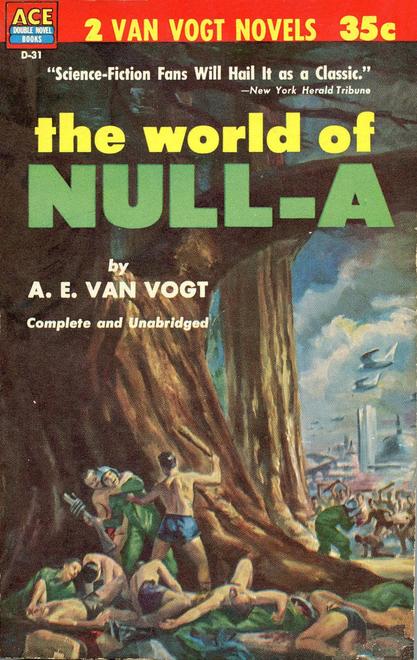 |
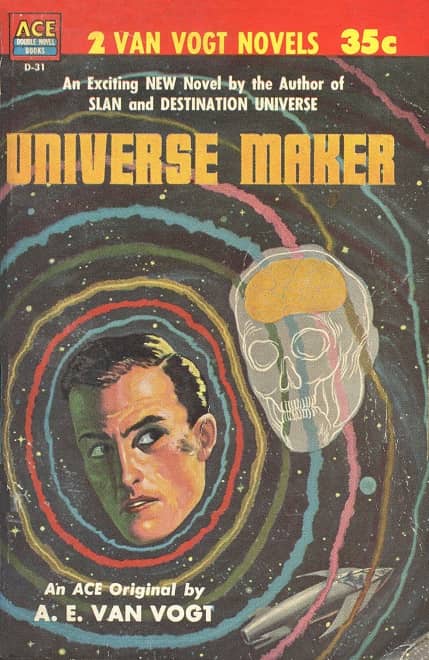 |
Ace Double D-31: The World of Null-A (cover by Stanley Meltzoff)
paired with Universe Maker (cover by Paul Orban)
Just so you know where I stand, let’s get this out of the way right off the bat — I love Ace Doubles (and if you don’t know what an Ace Double is, are you ever in the wrong place. You should immediately go to Slate or HelloGiggles or Shia LaBeouf.com or somewhere, anywhere else or risk irreversible contamination. You’ve been warned.) I’ve loved them ever since the first time I laid eyes on one, in the thrift store that was around the corner from my middle school. The day I pulled the dual volume of A.E. Van Vogt’s The World of Null-A and Universe Maker (D-31) off the dusty shelf, I fell and fell hard; my lunch money never had a chance. I have a lot of reasons for loving these books, some of which have nothing to do with the quality of the writing found between their gaudy covers, and a good thing too, but we’ll get to that. First, though, the looooove.
To begin with, I love them for those aforementioned gaudy covers, and why not? For twenty years, from 1953 to 1973, from D-31 to 93900 (mastering the Doubles numbering system is an arcane science in itself, especially the legendarily convoluted final five-digit series), artists like Ed Emshwiller, Kelly Freas, George Barr, Jack Gaughan, Gray Morrow, Ed Valigursky and many others poured forth a stream of wonderful images that amount to a romp in a candy shop of pulp science fiction props: mutants, ray guns, futuristic metropolises, bug eyed monsters, alien armadas, hostile planets, a-bomb shattered landscapes, femmes in danger, dangerous femmes, space stations, super-submarines, time machines, jut-jawed heroes in bubble-helmeted spacesuits, robots, domed cities… and, of course, spaceships, spaceships, spaceships! What, I ask you, is there not to love about that?
[Click the images for Double-sized versions.]
Ace Double D-150: Agent of the Unknown (cover by Ed Valigursky)
Then there’s the much-mocked but utterly irresistible format (are these books dos-à-dos or tête-bêche? I’ve never been able to keep it straight) in which, according to John Clute and Peter Nicholls’ invaluable Encyclopedia of Science Fiction, “two books are bound together so that they share one spine, but with their texts printed upside-down in respect to each other… such a volume has two front covers and two title pages, which the reader can confirm by turning any example upside-down, when a second front cover will appear, right way up, and a second text, likewise.”
The goofiness of the format is undeniable, but it’s delightfully goofy, giving you two outlandish covers, two sets of breathless blurbs, and two complete books for the price of one. The two books are admittedly short (usually a little over a hundred pages each), but in a world where carelessly reading a single novel can commit you to a lifetime of indentured servitude (I’m talking to you, George R.R. Martin), the very brevity of Ace Doubles is a virtue, as they can be finished in a sitting or two, after which you can get on with your life. The bold red-and-blue spines of the earlier volumes are also a plus, adding eye appeal to any bookcase. (Does any double aficionado actually prefer the later blue-and-white color scheme? If so, I’ve never met one.)
Ace Double D-237: The Secret Visitors (artist unknown)
Speaking of breathless blurbs, another nifty feature that appeared in many (though not all) doubles is a sort of teaser in the form of a cast of characters that comes right before the title page. From my copy of The Secret Visitors by James White (D-237):
Dr. LOCKHART
His patients were half-animal, half-spaceship!
HEDLEY
He wanted to save a country, but first had to save a world.
CEDRIC
English was his native tongue — seventeenth century English!
KEELER
The FBI had trained him to expect almost anything, except an invisible enemy.
KELLY
Hers was an ideal planet — almost.
JUNIOR
In his hand, a water pistol was a deadly weapon.
After a preview like that, who wouldn’t want to read on? As an added bonus, sometimes these character summaries (like the covers) actually come close to matching up with the text inside.
But mentioning the inside text inevitably leads us (though I’ve been trying my best to avoid it) to the actual stories that appeared in Ace Doubles. In a recent comment thread here at Black Gate, some snarky wise guy cracked that reading an Ace Double is “like playing Russian Roulette with four loaded chambers.” I have it on good authority that the jerk who made that remark owns one hundred and thirty Ace Doubles, and while I… er, he… aw, crap… I can’t claim to have read them all, I have powered my way through an unholy number of them, more than enough to back up such a harsh judgment. I think a rough two-to-one ratio of bad to good is fairly accurate, and honesty demands acknowledging that at their too-frequent worst, these books can be stupefyingly, surreally bad.
Donald Wollheim
The reasons for this are simple: time and money. Ace paid next to nothing for these things. Years later, the editor who oversaw the Doubles, Donald Wollheim, laid out how it worked:
We’d buy your novel as part of an Ace Double, pay you maybe $750 or maybe $500, and you’d get a royalty of 3 to 4 percent. It wasn’t a good deal, but it was the only game in the business… I think I can remember instances where a book came within $2 of earning royalties — and then nothing. It’s ridiculous.
Many Doubles that weren’t originals first appeared in low-rent Ziff-Davis magazines (primarily Amazing) before migrating to Ace, and Amazing was definitely in a different neighborhood than the relatively upscale Galaxy, Analog, or F&SF. The folks who wrote Ace Doubles didn’t carefully craft them to realize a burning vision or advance the art of fiction — they cranked them out to pay the rent. They wrote them fast and dirty and didn’t look back; neither their landlords nor the phone company would permit them that luxury.
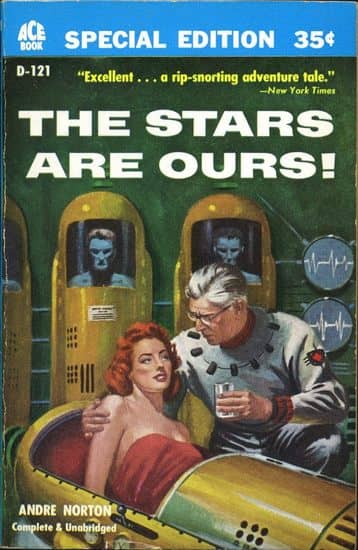 |
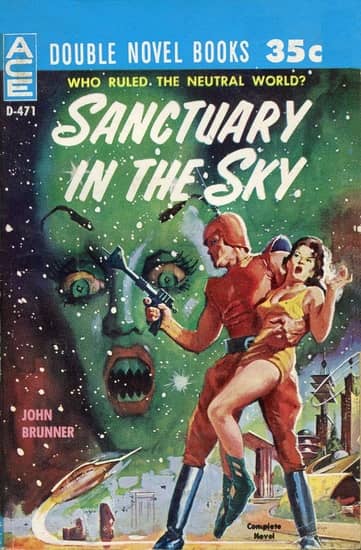 |
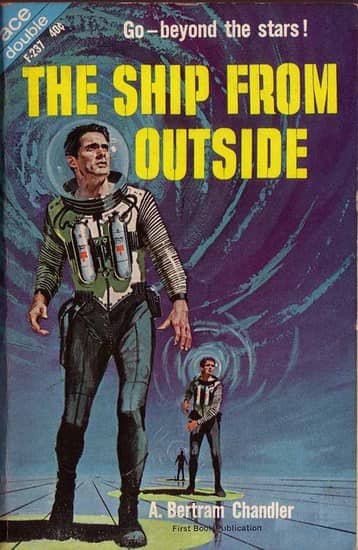 |
D-121: The Stars Are Ours! (art by Ed Valigursky), D-471: Sanctuary in the Sky (Basil Gogos), F-237: The Ship From Outside (Ed Valigursky)
These writers were, if you will, hacks (“a writer who works on order: also: a writer who aims solely for commercial success,” according to Merriam-Webster), but that’s not necessarily a condemnation. Successful hacks are able to earn a living in hardscrabble, low-paying genres, so it means that what they lack in literary ambition, they make up in storytelling efficiency and professionalism, resulting in books that may not be original but are at least competent… some of the time, anyway. But the pressures of having to maintain a high rate of production in order to, you know, eat, undoubtedly kept Doubles serfs from writing as well as they could have in more ideal circumstances.
Those Doubles writers who can justifiably reject the “hack” label are major talents whose early work appeared in the format. By the time they were producing their best books they had left Doubles far behind, but that’s no reason to disdain their apprentice labors. Indeed, it’s fun to see these writers trying out the themes and ideas that they will later develop more fully in their better known works.
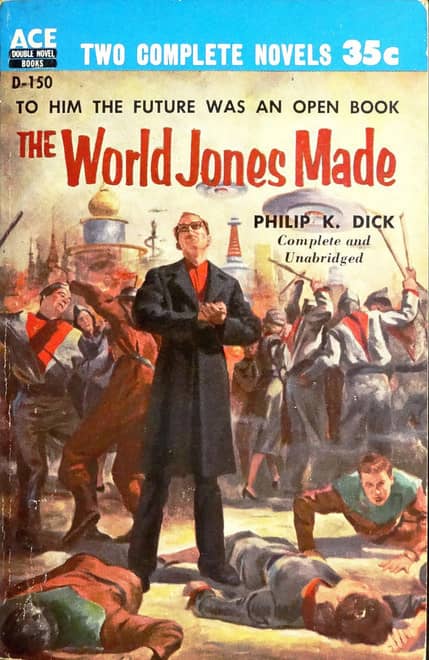 |
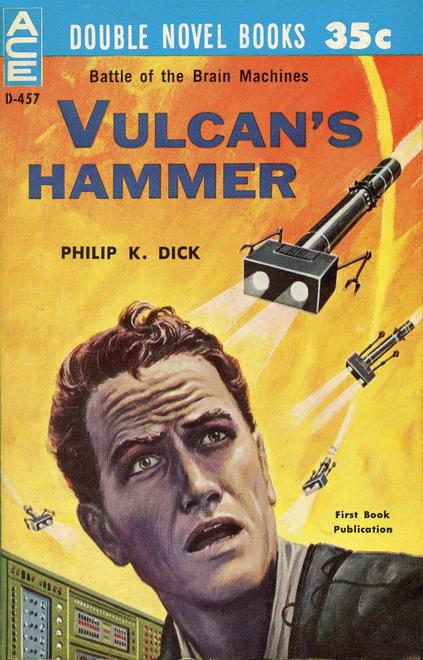 |
D-150: The World Jones Made (cover by Robert Schultz), D-457: Vulcan’s Hammer (cover by Ed Emshwiller)
Be aware though, that the spread is pretty wide even for the great writers who started out in Doubles. For instance, in The World Jones Made (D-150), Philip K. Dick produced a flawed but still very lively and interesting novel that’s worthy of any science fiction reader’s attention; in Vulcan’s Hammer (D-457) he tossed out what is almost universally labeled the worst thing he ever wrote. (Dick’s biographer Lawrence Sutin called it “dreck.”) Both books, light-years apart in quality, earned the same meagre ration of chicken feed Wollheim described. It’s not exactly an incentive to do your best work.
As for lesser known writers (certainly a kinder term than “hacks”), well… that’s where it really gets interesting. “Ziff-Davis welcomes Ernest Hemingway to its stable of writers!” is a headline that never appeared in the trade papers, and the talent level among what might be called the “average” Doubles writer is highly variable, to say the least. That’s what makes reading an Ace Double a gamble, but for those of us who are addicted to them, this very grab bag, leap in the dark, what the hell aspect is one of the things that makes theses books so much fun.
 |
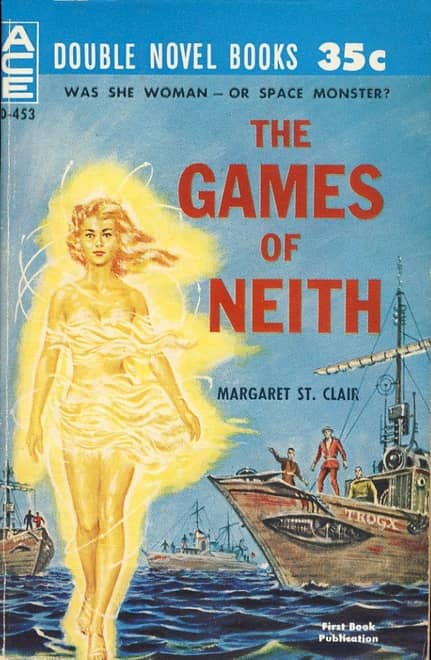 |
D-453: The Earth Gods Are Coming (art: Ed Valigursky) paired with The Games of Neith (Ed Emshwiller)
But there’s no denying it — Ace Doubles are not for the faint of heart, and any time you crack one open, you figuratively risk blowing your brains out. Among my many fatal encounters, The Earth Gods Are Coming by Kenneth Bulmer (D-453) always comes first to what’s left of my mind. This is an excruciatingly bad book, a dull, incoherent farrago that reads like it was written by the victim of a severe head injury and then hastily translated from the Mayan or Sumerian by someone else who barely knew English. I could easily substitute The Darkness Before Tomorrow by Robert Moore Williams (F-141) or The Light of Lilith by G. McDonald Wallis (F-108) as examples of the trauma that Doubles can inflict.
Sometimes, though, instead of finding yourself dead on the floor after finishing a Double, you are delighted to discover that you’re alive and well and happy after reading a darn good story. For example, Agent of the Unknown by Margaret St. Clair (D-150) takes some familiar devices (artificial planets, galactic conspiracies, mutant supermen) and plays them against the reader’s expectations, resulting in a surprising — and surprisingly moving — story. On the other hand, St. Clair’s The Games of Neith (D-453… the flip side of The Earth Gods Are Coming, in fact… a real winner, that D-453) is a complete mess. Remember — for every click, there are two bangs.
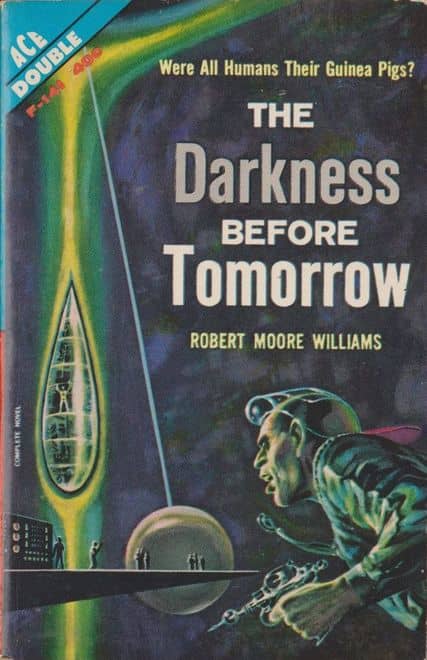 |
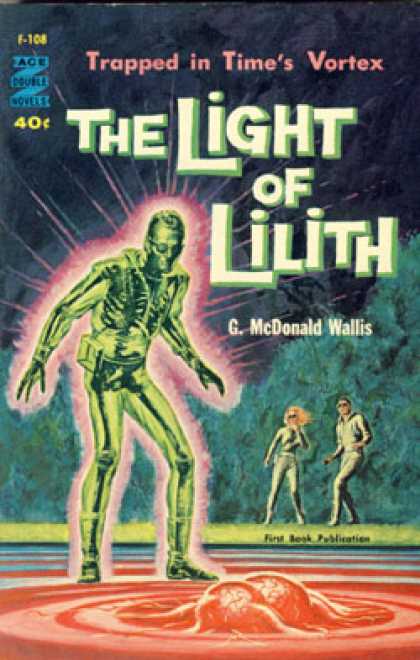 |
F-141: The Darkness Before Tomorrow (art by Ed Emshwiller), F-108: The Light of Lilith (Ed Emshwiller)
A little experience can help a Doubles reader improve those odds a bit, however; you will soon learn which writers are more likely (often much more likely) to produce winners. John Brunner was a master of taking stock science fiction situations and devices and making them seem new and original. I’ve never read anything by him in an Ace Double that wasn’t worthwhile. The same can be said of Andre Norton (who could always be trusted to tell a fast-paced, satisfying story) and A. Bertram Chandler, who published many of his highly enjoyable John Grimes space operas in the doubles format, along with other assorted stories set in his appealing rim worlds milieu.
Andre Norton
These three writers alone saw a lot of their work appear in Ace Doubles, and when you add early work by people like Philip K. Dick, Samuel R. Delaney, Ursula LeGuin, Mack Reynolds, Fred Saberhagen, Robert Silverberg, and Gordon Dickson, along with new work and classic reprints by veterans such as Leigh Brackett, Edmond Hamilton, Murray Leinster, Poul Anderson, Jack Vance, and A.E. VanVogt, you have plenty of good reading.
A. Bertram Chandler
Of course, there’s a wide middle ground of books which are neither very good nor very bad. This is where the hacks… er, pros have a chance to show what they can do under the severe limitations of the format, and it’s also where you find out whether Ace Doubles are really your thing. How committed are you to the common material of pulp science fiction? Do you demand that a crew crash-landed on a hostile alien planet go through their paces in graceful, polished prose? Do you want them to display subtle character touches and deep motivations? Must you have pages filled with original problems and surprising solutions? Is airtight plotting a necessity, or does a hole or two (or three) completely kill your enjoyment?
If the answer to any of these is yes, you should probably pass on most of these books. But if your pulse quickens even slightly at the bare fact of a crew crash-landed on an alien planet, if you can gain some measure of enjoyment from a standard situation because of the very fact that it is a standard situation, if you savor the time honored tropes and trappings and devices that go all the way back to the early days of the genre, if you love science fiction as science fiction, for the things, whether well employed or not, that make it distinct from any other genre… well then, you’ve hit the jackpot.
John Brunner
Then make sure you’ve got plenty of shelf space for old paperbacks with red-and-blue or blue-and-white spines. (There are even a few in the D-series with a red-and-black color scheme. I never could figure out what was going on with those.) And as for the dreaded two-to-one ratio, when you consider how fast these books were written and how little money the writers were paid for them (to say nothing of the complete absence of any non-monetary inducements to make them better), the remarkable thing is not that so many are bad, but that so many are good.
Ace Double D-149: King of the Fourth Planet (art: Ed Emshwiller)
The last Ace Double I read, just a couple of months ago, was King of the Fourth Planet by Robert Moore Williams (F-149). Williams killed me dead with his dreadful The Darkness Before Tomorrow, but when I turned the last page of King of the Fourth Planet, I thought, “Hey! That was pretty good!”
I’d taken a gamble and lived to read another day. It’s that kind of reckless thrill that keeps us Ace Double lovers spinning the cylinder, pulling the trigger, playing the game.
Thomas Parker is a native Southern Californian and a lifelong science fiction, fantasy, and mystery fan. When not corrupting the next generation as a fourth grade teacher, he collects Roger Corman movies, Silver Age comic books, Ace doubles, and despairing looks from his wife. His last article for us was a review of Tuck Everlasting.
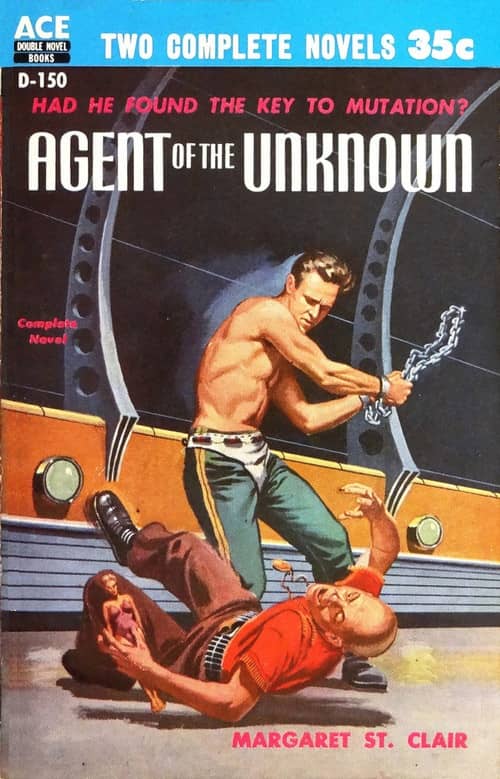
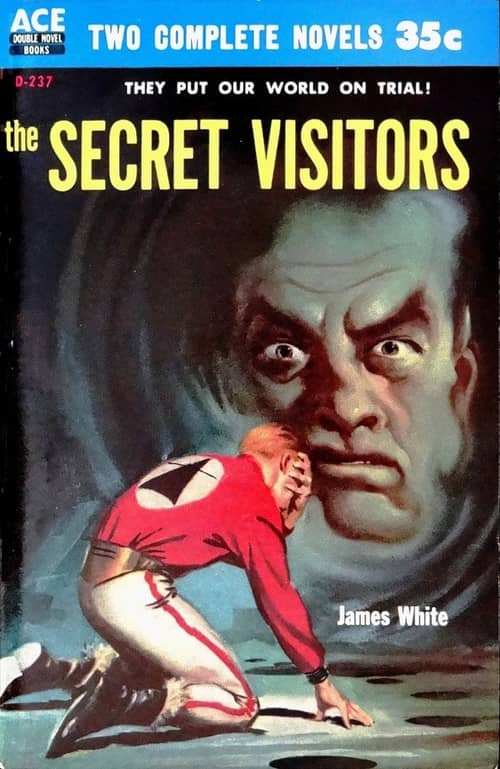
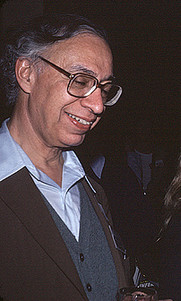
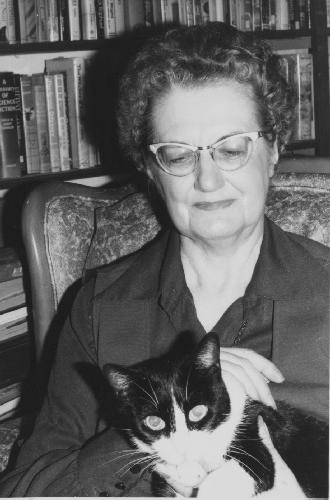
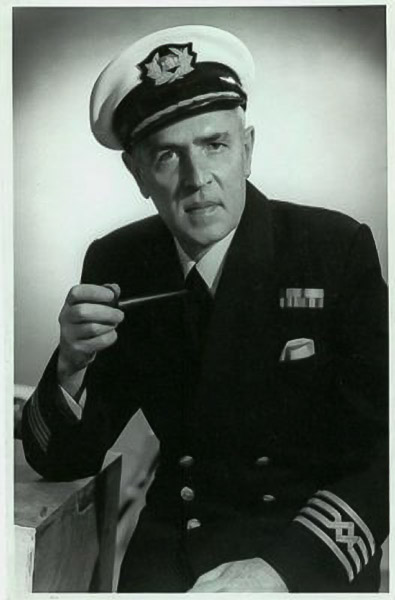
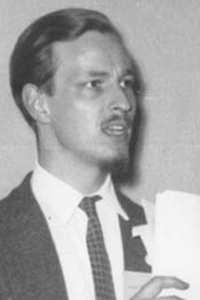
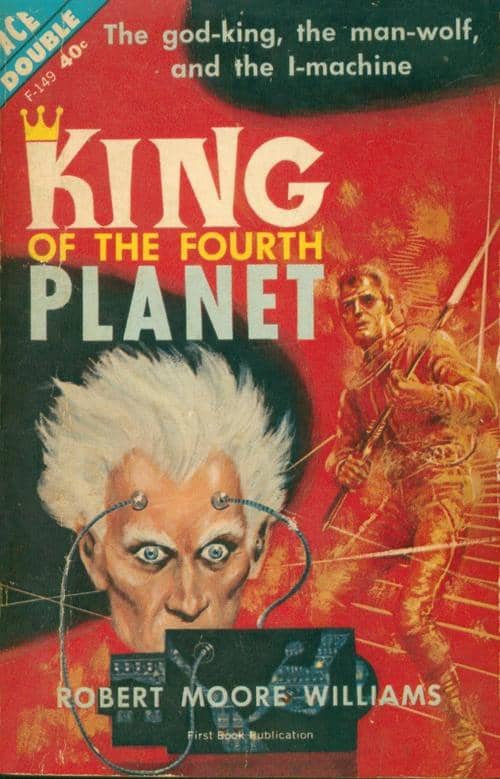
You summed it all up so well Thomas. For me what started as a mild foray has become a compulsion. Yes the familiar quickening pulse when I spot one at a flea market or second hand shop and reach for my phone with its quick list of ones I have. The heart dropping disappointment if I realise I already have that volume. For me I soldier through the bad ones. As you stated so eloquently, many of these were written to put bread on the table, so I just take them as they come and enjoy the odd gem.
This is a site that I have found invaluable in my Doubles quest. It lists all volumes in the various series, with cover images and artist info for most.
http://people.uncw.edu/smithms/ACE_doubles.html
Great write-up of the series, Thomas! Makes me want to be DOUBLY on the lookout for them.
I grew up reading ACE Doubles. Your post brought back a lot of fond memories of these books. This was an incredible series!
This article is enough to turn anyone into an Ace Doubles collector. You’re just adding competition for yourself (and John.)
Your enthusiasm really comes through. My local Half Price Books has a vintage paperback section. I’ve never seen one of these there. But if i do i’ll have to snag it.
My biggest beef with Ace Doubles is that, as good as they look in my hand, there is no way to turn them on my shelf that doesn’t look WRONG.
My wife complained for most of our 25-year marriage about my ‘stacks and piles’ of books. We lived in 6 different houses, and NEVER had a place to properly display any of my books. But 3 years ago, we opened the home I now live in to the public for a ‘Home & Garden’ tour, and my wife insisted I display my Ace Doubles in an upstairs book cabinet. It attracted less attention than I might have expected, but my wife beamed with pride when anyone mentioned the collection. I think she was almost as pleased as I was. It’s the only part of my collection I’d NEVER consider selling.
Fantastic article! I’ve always been a fan of the Ace Doubles: I started reading them when I was a kid. Sure, they weren’t all great reads, but then, the same can be said for a lot of “single” novels. I miss those days.
As you might guess, I am delighted with all discussion of Ace Doubles — I think your estimate of the ratio of good to bad ones is about right!
[…] Black Gate » Doubling Down, or Just How Bad Are Ace Doubles, Anyway?. An exuberant review of the good, the bad, and the ugly of an SF publishing institution. […]
I always loved the Ace Doubles and I appreciate this article. I’m quoting from it in a Facebook post I’m currently doing on Ace Doubles. My own writing style has been influenced greatly by some of the stuff I read in my teens in Ace Double format.
Thank you for the kind words – it’s always nice to get a fresh comment on something that you wrote five years ago!
I too discovered them in a thrift store, for me 65 years ago. I think Van Vogt’s Aces were better than this late books. Asimov’s Foundation was an Ace. (I went to grad school with Asimov’s nephew. Said his uncle was an albatross around his neck because people were always asking about him.)
What intrigued me was that within a certain time period they all had the same number of pages. I think the early ones were 320 or 310 pages. Later years had fewer but again all the same. The authors must have talked to each other so that the two novels added up to the right number of page.